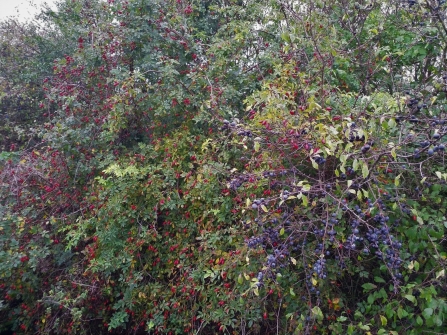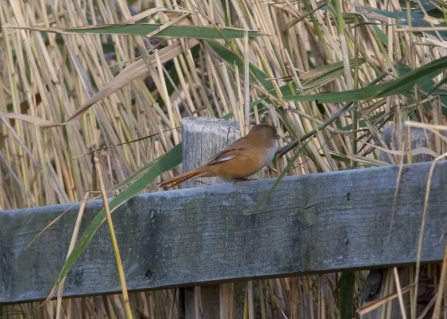Our theme for October is Nature’s Harvest, and the land here has provided plenty of food for the wildlife to make the most of, most notably being berries so far, with many more just starting to ripen and brighten the hedgerows now. We’ve also been really excited to see one of the species which is using the reeds..!
Berries
Most of the blackberries were ripe towards the end of August this year, and we were happy to see many birds darting amongst the brambles to make the most of them.
This Common Whitethroat spent a good while selecting the best berries to eat, as can be seen by the interesting positions it got into!
Other berries which start to ripen across the reserve at this time of year include sloes, hawthorn and rose-hips. These are taken advantage of by flocks of striking Redwing and Fieldfare, amongst other species, after they start to arrive here this month. We’ve not spotted them at Blue House Farm yet this Autumn, but the reserve is certainly prepared with plenty of food for them already.

Here at Blue House Farm, as well as the wildlife, we also have our own enthusiastic berry-eaters..!
Reeds
Another habitat-type providing food for the wildlife to harvest here at Blue House Farm is the reed-beds. We are very lucky to have Bearded Tits (a Schedule 1 species) on the reserve, and they’ve been showing well recently – much to our excitement – in some of the reeds on the reserve. This elusive species has a mixed diet which includes invertebrates and reed seeds. We’ve been over the moon to have seen them making the most of the reeds in the past couple of weeks.
Bearded Tits are intermittently heard by visitors near to the first bird hide along the permissive footpath, and this is one of the places we've noticed more activity than usual recently. Another place they can be seen on the reserve – we spotted them a few times during our breeding bird surveys this year – is in the reedbed on your left if you continue East along the sea wall public footpath, beyond the permissive footpath loop. One of our volunteers has also put up a grit table which can be seen from the third hide along the permissive footpath, as these birds (like many other species of bird) swallow grit to help them grind up their food.
We hope you get the opportunity to see this beautiful and often shy species on the reserve – please let us know if you do!

Courtesy of John Lilley

